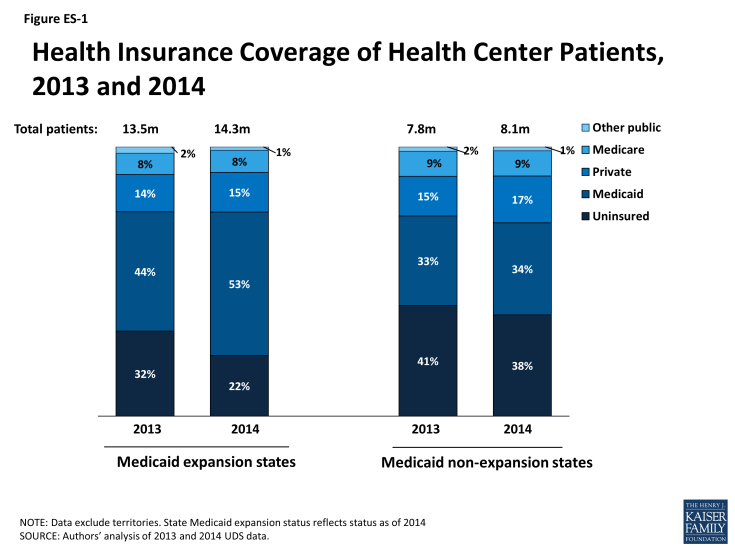Health Center Patient Trends, Enrollment Activities, and Service Capacity: Recent Experience in Medicaid Expansion and Non-Expansion States
In thousands of medically underserved communities across the U.S., community health centers enroll low-income people in health coverage and provide care to millions of patients. Against the backdrop of significant health center expansion over several years and a full year of expanded health coverage under the Affordable Care Act (ACA), this brief examines change between 2013 and 2014 in the volume and health coverage profile of health center patients, and health center enrollment activities and service capacity, comparing states that implemented the ACA Medicaid expansion in 2014 and states that did not expand Medicaid in 2014. The study is based on 2014 data from the federal Uniform Data System and a 2014 national survey of health centers.
Several key findings emerged from the analysis:
- In 2014, health centers served 22.5 million patients – an increase of nearly 1.2 million patients over 2013. From 2013 to 2014, the number of health center patients covered by Medicaid rose by 1.85 million, or 22%.
- Between 2013 and 2014, the share of health center patients covered by Medicaid rose from 40% to 46%, the share with private insurance rose from 14% to 16%, and the share who were uninsured declined from 35% to 28%.
- Changes in health center patient coverage were sharply different between Medicaid expansion and non-expansion states (Figure ES-1). In expansion states, the share of patients with Medicaid rose by 20% and the share who were uninsured fell by 29%. In non-expansion states, the share with Medicaid rose by 3% and the share who were uninsured fell by 8%. Private coverage rates remained low in both groups of states because most health center patients have income below the poverty level and are thus ineligible for Marketplace subsidies.
- During the first ACA open enrollment period, the vast majority of all health centers provided Medicaid application assistance, but expansion states were more likely to assist with renewing Medicaid and selecting Medicaid plans, while non-expansion states were more likely to assist with Marketplace applications and Qualified Health Plan selection.
- Health centers in expansion states were significantly more likely than those in non-expansion states to report having expanded their capacity for dental and mental health services since the start of 2014. They were also more likely to report increased wait times for appointments, possibly reflecting greater increases in demand for services associated with larger gains in coverage among health center patients in these states.



